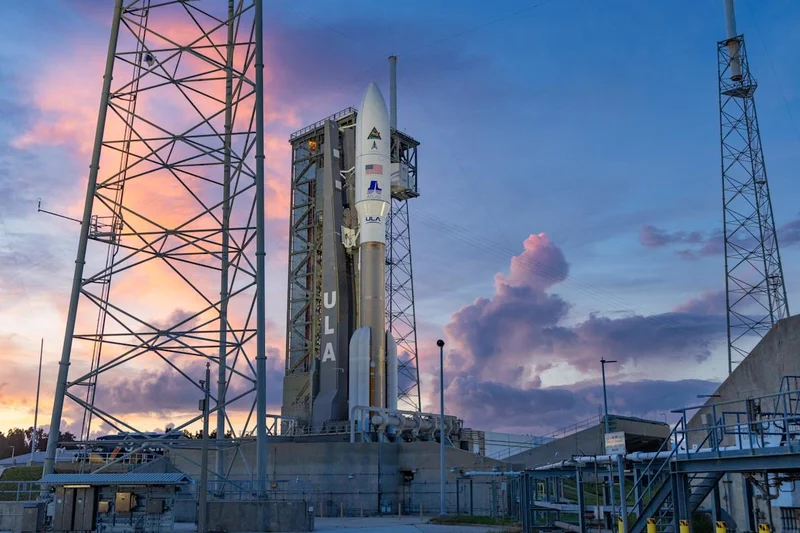The Numbers Don't Lie: ViaSat-3 F2 Faces a Tight Schedule
The United Launch Alliance (ULA) is set to launch its Atlas V rocket carrying the ViaSat-3 Flight 2 (F2) mission on Wednesday, November 5, 2025. The launch window, from Space Launch Complex-41 at Cape Canaveral Space Force Station in Florida, opens at 10:24 p.m. EST, with a mere 44-minute window. The Launch Readiness Review (LRR) gave a "GO," but let's dissect what that really means. UPDATE: ULA’s Launch Readiness is GO! for Wednesday ViaSat-3 Flight 2 one of the most powerful commercial communication satellites - news.satnews.com
The Atlas V: A Numbers Game
The Atlas V 551, designated AV-100, stands at 196 feet. More importantly, it promises 2.7 million pounds of thrust at liftoff. That’s 12 megaNewtons for those of us who prefer metric. ULA is rolling the rocket out to Space Launch Complex 41 (SLC-41) the day before launch, a standard procedure, but always a point where things can go sideways. The weather forecast is showing a 95% chance of favorable conditions. Cumulus clouds are the primary concern, and while the 24-hour backup forecast shows only a 10% probability of violating weather constraints, that still leaves a 1 in 10 chance of a scrub.
ViaSat-3 F2, the payload, arrived at Cape Canaveral on September 30, 2025, transported by an Antonov AN-124 cargo plane from Boeing’s facility in El Segundo, California. The satellite is designed to more than double the bandwidth capacity of Viasat’s existing fleet. Viasat claims that ViaSat-3 F2 is expected to add more than 1 Tbps capacity to Viasat's network over the Americas upon service entry in early 2026. Is that realistic?
Bandwidth Promises and the Reality Check
Dave Abrahamian, Vice President of Space Systems, Viasat, expressed pride in the Viasat team and partnership with Boeing, stating that being a few weeks from launch is "incredibly exciting." Of course, he would say that. The real question is, can this satellite deliver?

The Atlas V rocket will place the ViaSat-3 Flight 2 spacecraft into a geosynchronous transfer orbit (GTO). From there, the satellite will propel itself to GEO (approximately 22,000 miles above the Earth’s equator) over the coming months. This is where things get tricky. The satellite needs to execute a series of precise burns to reach its final orbital position. Any miscalculation or malfunction could leave the satellite stranded in the wrong orbit, or worse.
ViaSat-3 F2 is the second of three ViaSat-3 Ka-band satellites built by Boeing. The first one suffered a major anomaly during its deployment, rendering it largely useless. (The exact financial impact of that failure is still being debated in insurance claims.) This puts even more pressure on F2 to perform flawlessly. If this launch fails, the repercussions for Viasat will be significant.
James Whelan is the ULA Launch Director. His job is to ensure that everything goes according to plan. But even the best launch director can't control the weather, or guarantee that a complex piece of machinery won't fail. That 5% chance of unfavorable weather conditions might as well be 50%, given the stakes.
The Margin for Error is Zero
Viasat needs this launch to succeed. The company has invested heavily in the ViaSat-3 constellation, and the failure of the first satellite has already set them back. The clock is ticking. The promised service entry in early 2026 leaves little room for error. If the launch is delayed or the satellite encounters problems during deployment, Viasat could miss its target date, further eroding investor confidence.
So, What's the Real Story?
Viasat is walking a tightrope. The company is promising a massive increase in bandwidth capacity with the ViaSat-3 F2 satellite. But the launch is just the first step. The satellite needs to navigate itself to its final orbital position, and it needs to do so flawlessly. With a history of anomalies and a tight schedule, the margin for error is virtually zero. The numbers paint a picture of high risk, high reward, and a company that’s betting everything on a successful outcome.
